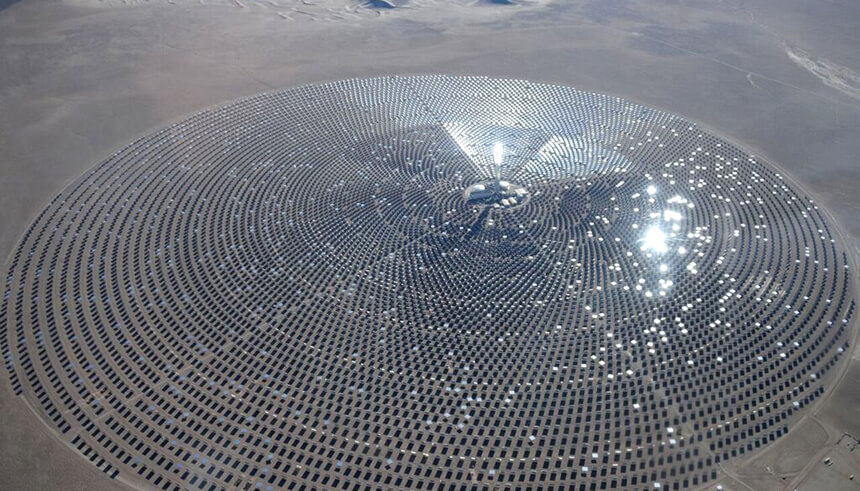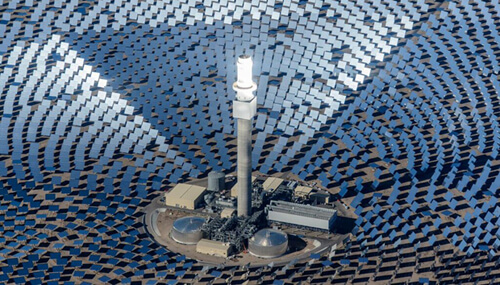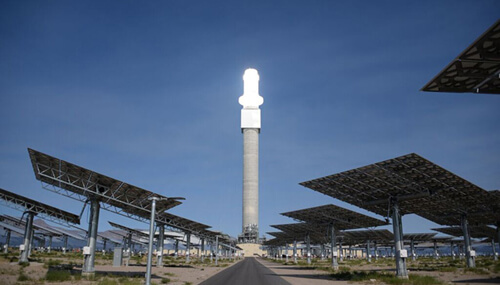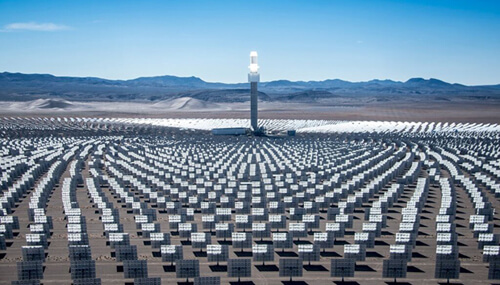U.S.-Asia Business
How a Solar Plant Can Run Around the Clock, Even After Sunset

Futuristic solar thermal power uses 10,000 mirrors to generate electricity all night long.
From tax subsidies for American homeowners who install solar panels on their roofs to China’s massive buildup in new solar capacity, to Germany's so-called “energy transition” that relies heavily on solar power, it's fair to say that generating electricity from sunshine has come of age.
One of the most curious forms of solar power has nothing to do with photovoltaic panels in solar farms or installed on rooftops. It's a technology called solar thermal power, also known as concentrated solar power. To see one of these facilities from a bird's eye view, it looks as if an alien has landed in the desert.
While the cost to produce power from solar thermal is still pricier than conventional photovoltaic panels, solar thermal has an ace in its back pocket — it can run after sunset.
One of the newest concentrated solar plants is Crescent Dunes, operated by SolarReserve LLC of Santa Monica, Calif., which opened in 2015. Located in southwestern Nevada, not far from a lonely stretch of blacktop that locals call the Extraterrestrial Highway, Crescent Dunes spans 1600 acres of pure Great Basin Desert wilderness.
At its center is a 640-foot tower, topped by sensors and boilers to generate steam. Surrounding the tower is a spiral of 10,000 mirrors, all squarely aimed at the tower's pinnacle. The mirrors' purpose is to redirect the inferno-like heat from the Nevada sun onto the tower, heating salt into a molten state of 1,000 degrees Fahrenheit (more on the salt later). The molten salt then goes through a generator, which creates steam, which spins a turbine to create electricity.

"Surrounding the tower is a spiral of 10,000 mirrors, all squarely aimed at the tower's pinnacle."
Helping meet renewable standards
Crescent Dunes is one of more than a dozen solar thermal plants operating in the United States, in California, Nevada, Arizona, Utah, Florida and Hawaii. Most solar thermal facilities have come on line in the past decade, and most have some sort of power-purchase agreement with utilities. For example, NV Energy in Las Vegas has a 25-year contract with Crescent Dunes to buy electricity, enough power for about 75,000 homes during peak demand.
Solar thermal plants like Crescent Dunes are critical to the nation’s effort to shift from fossil fuel-based energy like coal to sustainable sources, energy experts say. As more governments mandate the increased use of sustainable, renewable energy, concentrated solar power is expected to grow.
“Some projections show CSP playing a significant role in meeting California’s new 50 percent Renewables Portfolio Standard,” says Amit Ronen, director of the GW Solar Institute at The George Washington University.
Crescent Dunes isn't even the biggest solar thermal plant in the United States. That title belongs to the Ivanpah Solar Electric Generating System, which produces enough power for about 140,000 homes. Ivanpah, co-owned by BrightSource Energy Inc. of Oakland, Calif., is located in the Mojave Desert on the California-Nevada state line. Ivanpah's owners have a contract to generate electricity for Pacific Gas and Electric Co., an electric utility in central and northern California.
Salted sunshine
With solar thermal power, it's all about salt. To be specific, reservoirs of molten salt. Tanks of molten salt absorb heat energy during peak periods of sunlight; the energy can be released later through transfer to water.
In short, solar thermal power plants can literally run all night, with the ability to produce power for up to 10 hours after the sun has set, according to IEEE, the Institute of Electrical and Electronics Engineers.
Moreover, molten salt technology provides energy storage at about 10 percent of the cost of utility-scale battery storage.
"Solar thermal power plants can literally run all night, with the ability to produce power for up to 10 hours after the sun has set."

As the cost of photovoltaic panels has dropped over the years, the total cost of PV-based solar energy is less expensive than concentrated solar power. But the superior storage capacity available through concentrated solar power may be its best feature, Ronen says.
“The ability of CSP to easily integrate storage may provide the technology an edge in certain applications,” Ronen says. “As solar penetration rates increase in any particular region, the ability to deliver power when and where it's needed will become increasingly important in determining the financial feasibility of a project.”
China's plans for solar
Solar thermal power also appears ready to be expanded to other parts of the world. Spain and the United States are, by far, the current leaders in solar thermal capacity. But new projects have been announced in a number of other countries, or are under construction, including in China, Morocco, Israel, Chile and India.
SolarReserve, the developer of Crescent Dunes in Nevada, in May announced an agreement with Shenhua Group Corp., a Chinese government-owned energy company, to construct 1,000 megawatts of solar thermal capacity in the country. Shenhua is the world's largest coal supplier and its role in the project is to lead on development, financing, construction and operations.
“Our 1,000 megawatt partnership with Shenhua is at a scale that will lead to substantially lower costs,” says Kevin Smith, SolarReserve's CEO, “while contributing clean and renewable energy to China’s growing power needs.”
China plans to build a total of 10,000 megawatts of concentrated solar power during the next five years, says Ling Wen, CEO of Shenhua Group.

"China plans to build a total of 10,000 megawatts of concentrated solar power during the next five years."
Germany's energy revolution
In Germany, a national effort, “energiewende,” is underway to transition to renewable energy sources. Germany wants to increase renewable energy use from 25 percent to 60 percent of total consumption within the next 20 years, according to the Heinrich Böll Foundation.
Adding that much capacity from solar power in Germany is a special challenge, because its territory does not include areas that receive intense concentrations of sunlight. While Germany has been one of the leading countries in the world in the number of photovoltaic panels installed, both on rooftops and at solar farms, there's only so much energy that can be generated by voltaics, since Germany can be somewhat cold at times.
Which is where solar thermal plants come into play. German electric utilities have been involved in the financing and development of some solar thermal plants, including the Andasol Solar Power Station in southern Spain.
“I see this power plant as a role model for the rest of Europe,” says Hans Bünting, chief operating officer of the Renewables department for RWE International SE.
Environmental drawbacks
Solar thermal power has some significant drawbacks, some of which threaten the ongoing operation of some plants. The Ivanpah facility has been blamed for the death of thousands of birds, which are burned to death when they fly near the areas where heat is transferred from the mirrors to the tower.
Solar power is also more expensive in some areas, although tax subsidies help defray some of the cost. And the price to install or purchase solar power has dropped dramatically. In Germany, the price of solar power has fallen 74 percent since 2005, according to the Böll Foundation.
Then there's the issue of storage. One of the long-standing drawbacks of solar power is the obvious fact that, when the sun sets, it's much more difficult to generate power. Cloud cover, dust and snow can also hamper a solar panel's ability to generate power.
There are some battery-related technologies to help get around this fact, including an in-home battery manufactured by Tesla Motors called the Powerwall. SolarCity in San Mateo, Calif., makes use of Tesla's technology in its DemandLogic home energy-storage system.

